Georgia’s woodpeckers are some of the most interesting birds you can see in the south. If you like going out birding in the woods and forest, you can see or hear them drum on trees. Many Georgians may even routinely wake up to the peckers feverishly pecking away at trees in their own yard, looking for insects to eat. In this article, we’re taking a look at the woodpeckers in Georgia and some interesting facts about them.
Georgia has a warm climate, which attracts many different species of birds including woodpeckers. That’s why you can easily find these birds nearly everywhere in the state all year round.
We’ll be discussing the eight different species of woodpeckers in Georgia, their outstanding features, and everything you need to know about these birds.
These species include:
- Red-bellied Woodpecker
- Red-headed Woodpecker
- Downy Woodpecker
- Yellow-bellied Sapsucker
- Hairy Woodpecker
- Northern Flicker
- Red-Cockaded Woodpecker
- Pileated Woodpecker
- Ivory-billed Woodpecker (nearly extinct)
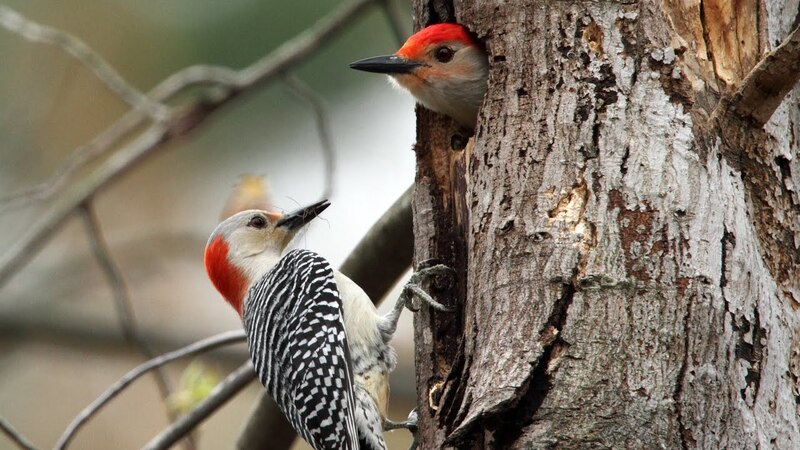
1. Red-Bellied Woodpecker (Melaners carolinus)
Wingspan: 13.0-16.5 inch
Length: 9.4 inch
Weight: 2.0-3.2 oz
Red-bellied woodpeckers have red caps; hence they can be mistaken for Red-headed woodpeckers though they are relatively smaller. They have gorgeous white and black spots over their backs.
Opposite their name, these woodpeckers have pale grey bellies with only less red coloration that’s hard to spot. However, this red coloring helps differentiate between males and females.
You’ll find the males with a bright red plumage at their beaks and extends to their neck’s back. For females, the red coloring is at the back of their necks but not at the crown.
These woodpeckers live in Georgia all year round. You can find them mostly near backyard bird feeders, especially those with peanuts, suet, or sunflower seeds, as these are their most favorite foods.
They also live in large trees found in the hardwood forests and woods. And you’ll see them perch on the tree’s dead trunks and main branches as they look for insects, fruits, nuts and seeds.
The dead trees provide perfect spots for them to make their nests for longer-term use. Like many woodpeckers, the Red-bellied Woodpeckers boasts a long tongue about two inches past their bills.
Their tongue has a sticky and barbed end for easy grabbing insects from deep crevices within the trees. The only way to make this long tongue fit in their beaks is by wrapping up and around their back’s heads.
To find these woodpeckers, you need to learn their “churr-churr-churr” rolling calls. The seasons where red-bellied woodpeckers are active callers is during the summer and spring. Therefore, you can listen closely in the forests, parks, and wooded suburbs during these periods.

2. Red-headed Woodpecker (Melanerpes erythrocephalus)
Wingspan: 16.5 inch
Length: 7.5-9.1 inch
Weight: 2.0-3.2 inch
The Red-headed Woodpecker is one of the most common species of woodpeckers in Georgia. They feature a large redhead, hence their name. Their bills are quite a bit larger than many other species.
Their bodies are covered in white feathers. Their backs are black, but the wings are white. Because of these features, the Red-headed Woodpeckers are easily identifiable. The young ones are less colorful, with all their plumage being almost gray-brown and white spots on their wings.
These woodpecker species often live in open woods that have clear pine savannas and swamps. Most people tend to cut down dead trees that these woodpeckers depend on for making their nests because of aesthetic reasons.
As a result, their population has reduced due to the loss of their habitats. Like any other woodpecker species, the Red-headed Woodpeckers reside in temperate Georgia all year round. You may see some of them visit your backyard birdfeeders that have suet, nuts, and fruits like apples, grapes, and berries.
When it comes to diet, these woodpeckers have something entirely different. That is, they hunt and capture insects flying in the air other than drilling into wood. Interestingly, these birds are very cautious about food shortages. That’s why they tend to store surplus foods such as seeds, insects, and nuts in their crevices for future use.
Their territories are a no-go zone for other birds, and they’ll protect them by all means possible. And the problem is, they scare away other birds as they can destroy the eggs and nests of other birds.
If you want to spot them, listen to them making calls “chur”, which sounds almost similar to that of Red-bellied Woodpeckers. The difference is that these woodpeckers’ sounds are quite higher-pitched and don’t have plenty of rolling.
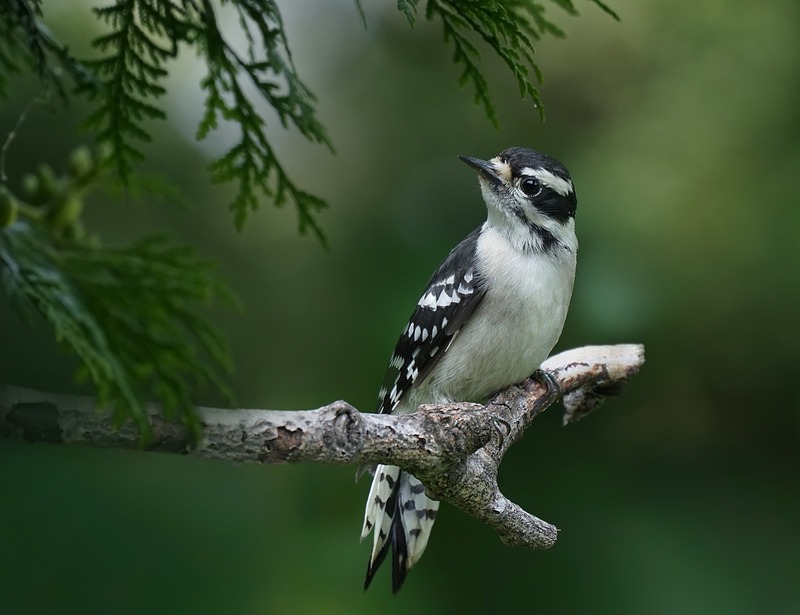
3. Downy Woodpecker (Picoides pubescens)
Wingspan: 9.8-11.8 inch
Length: 5.5-6.7 inch
Weight: 0.7-1.0 oz
Downy Woodpeckers are the smallest yet most common species of woodpeckers in Georgia. Their small size ranges between a robin and a sparrow, and they are generally the third smallest woodpecker. Unlike most woodpeckers, these birds have pretty short beaks.
When you see these woodpeckers, they are quite similar to the Hairy Woodpecker. But they have white bellies and black backs with white spots. The males have a distinct red patch at their head’s back, something that the females lack.
Downy Woodpeckers exist in Georgia year-round, and you can easily see them in open forests, orchards, and woodlands. Naturally, they tend to prefer deciduous trees with adjacent water sources. Still, you can also spot them in the parks, backyard, and other human development places with birdfeeders.
These woodpeckers are very active and fun to watch during the summer and spring seasons. That’s when you can hear Downy woodpeckers drumming and hammering into trees as they establish boundaries or look for mates. They make characteristic high-pitched “pik” calls that make them easily spotted.
During winters, these woodpeckers regularly join mixed-species flocks like chickadees and nuthatches. As a result, they tend to join efforts with other small birds for better protection and greater chances of finding a meal.
These woodpeckers often make their nests in dead tree cavities where they live and brood. Insects, mostly larvae and nuts, form their perfect diet but can also eat grains, berries, and acorns. Sometimes, these woodpeckers can be spotted drinking sugary water from hummingbird’s feeders.
Do you want to attract this woodpecker species to your backyard? Well, it is very easy. Put suet, peanuts like peanut butter, and sunflower seeds on your birdfeeders and wait to see them approach.
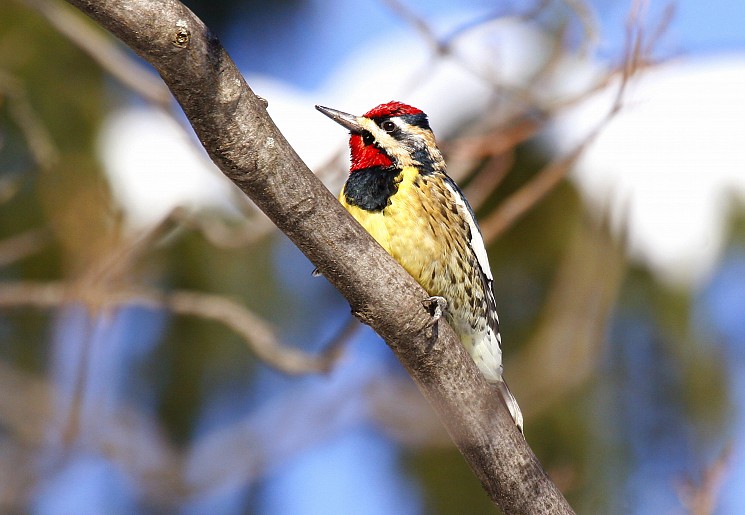
4. Yellow-bellied Sapsucker (Sphyrapicus varius)
Wingspan: 13.4-15.8 inch
Length: 7.1-8.7 inch
Weight: 1.5-1.9 oz
The Yellow-bellied Sapsucker exists as a migratory species of woodpeckers in the state. Generally, you’ll find them spending their wintertime in Georgia’s open lands and young deciduous forests. And that’s right after breeding in Canada and the Northern States of America.
As the name suggests, this woodpecker species features a distinct yellowish-white belly. They have a white and black backside and a relatively large white spot at their shoulder. Be sure to check out for their distinct red crown and black/white barred face.
To tell which one is a male or female, look out for their throat’s color. The males often boast a red throat, whereas the females have white throats.
These woodpeckers often rely greatly on tree sap that acts as a high energy food. As a result, they prefer habitats with growing trees which are excellent for making productive sap wells from which they can use their brushed-tipped tongues to draw out the sap from holes.
Although the Yellow-bellied Sapsuckers are known for making holes into over 1000 different trees, they tend to like the birch and maple tree species. Interestingly, these birds drill holes neatly organized into rows on living trees.
Since sap is their primary food source, these woodpeckers often maintain the holes for the continuous flow of sap. Like any typical woodpecker, these sapsuckers also eat insects that come to drink the sap on the trees.
You’ll first hear these birds make a loud mewing call, the same as for a cat, and it is usually repeated several times.
If you are looking to attract these woodpeckers, make sure you set up suet feeders that are squirrel proof. You can also opt for a peanut butter suet or mealworm suet.
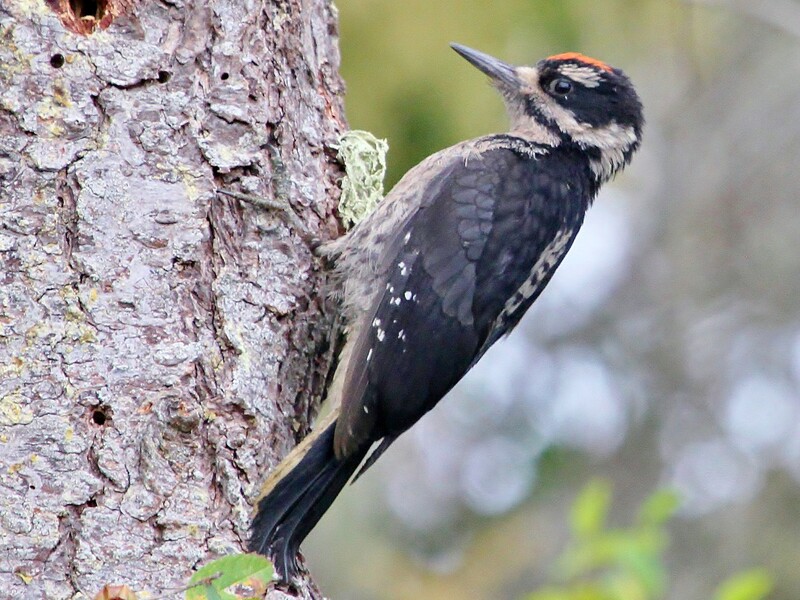
5. Hairy Woodpecker (Picoides villosus)
Wingspan: 13.0-16.1 inch
Length: 7.1-10.2 inch
Weight: 1.4-3.4 oz
Hairy Woodpecker often seems to be a cousin to the Downy Woodpeckers. These two woodpecker species can be pretty confusing. The main difference, though, is that Hairy Woodpeckers are larger and have longer bills.
These medium-sized woodpeckers feature a square-like head with their bodies generally covered in black and white plumage. You’ll also find them with a large white spot running down to the sides of their backs. The males have a distinct red flash stretching towards the backs of their heads.
The best part is that you can find Hairy Woodpeckers in the state all time of the year. They are pretty common in mature forests, swamps, urban parks, orchards, cemeteries, and suburban backyards. Indeed, you can find these woodpeckers anywhere with plenty of large trees.
These woodpeckers mostly eat insects like beetle larvae, dark beetles, and ants. They can also eat bees, spiders, caterpillars, millipedes, and moth pupae. You’ll find them nesting in cavities they drill on dead tree trunks or branches.
You can easily attract these woodpeckers to your backyard using suet cakes and black sunflowers. Make sure you use a squirrel proof suet feeder with a cage to help restrict entry by larger birds.
To spot them, listen to their distinct short and sharp “peek” call. However, this call is similar to that of Downy Woodpeckers, except that it has a relatively lower pitch. Listen also to the drumming sounds they make while feeding.
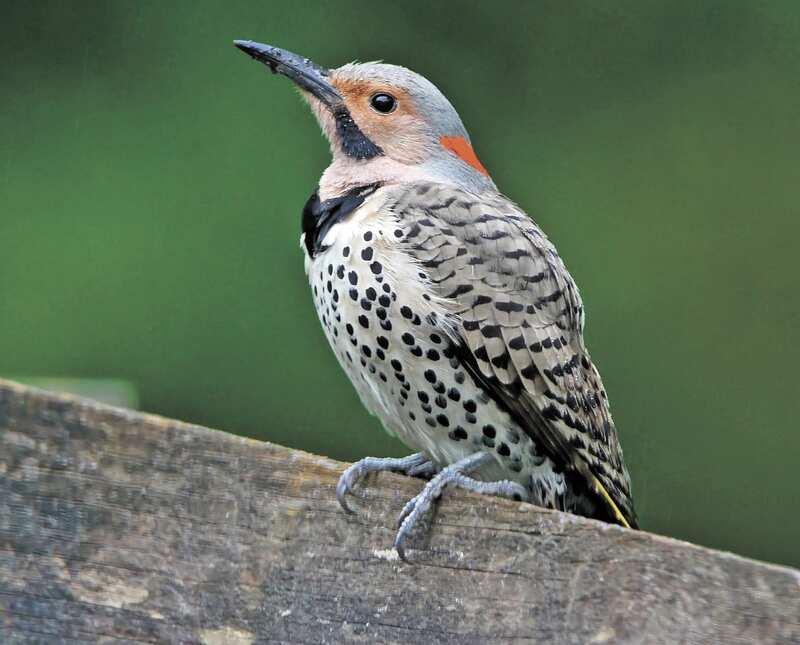
6. Northern Flicker (Colaptes auratus)
Wingspan: 16.5-20.1 inch
Length: 11.0-12.2 inch
Weight: 3.9-5.6 oz
Northern Flickers are fun birds to watch and are quite common woodpecker species in Georgia. They are relatively large and appear differently depending on where you live. Below are the two distinct appearance variations you need to watch for in this woodpecker species.
Yellow-shafted
This sub-species of Northern Flickers exists mainly on the eastern side of the state. They feature a red patch at their head’s back while their underwings and tails have yellow feathers, which are easily visible while flying.
The males are identifiable by a mustache stripe which females don’t have. And they all the sexes in this variety have brown faces and gray crowns.
Red-shafted
The red-shafted Northern Flicker variety resides in the western parts. To identify them, check for a red mustache stripe that both sexes have. Their underwings and tails have red-orange feathers, which are only visible when flying. Moreover, these sub-species have mainly gray faces with a brown crown.
Northern Flickers are unique, and their behaviors are different from that of typical woodpeckers. If you want to spot these woodpeckers, then you should look on the grounds of open woods, parks, and forest edges.
The thing is, these birds often spend most of their time on the forest grounds digging out beetles and ants – their primary source of food. In fact, they hit into the soil just like how other woodpeckers make cavities into trees.
When the winter season kicks in, these woodpeckers switch their diets to mainly fruits and berries. This tends to be the time you can spot them at birdfeeders in your backyard. You may find them stealing peanuts, sunflower seeds, and suet from your other birds.
If you want to attract Northern Flickers to your backyard, be sure to set up a suitable sized nest box to attract a breeding pair. Or, ensure that are many native plants that entice insect species in your backyard.
If they are not on the ground, these woodpecker species usually perch on the branches of trees.

7. Red-Cockaded Woodpecker (Picoides borealis)
Wingspan: 14.2 inch
Length: 7.9-9.1 inch
Weight: 1.5-1.8 oz
Red-cockaded Woodpeckers were rendered endangered after a massive loss of habitat back in 1970. But, you can still find them in Georgia all year round as they are non-migratory. Their most common residence is in the eastern part of the state.
While their name suggests otherwise, Red-cockaded woodpeckers have their bodies covered by very little red plumage. In fact, the males have a very minute and nearly invisible red spot behind their eyes. Besides having white cheeks, this woodpecker species has its entire body covered in black and white stripes, marks, and bars.
Since these birds are habitat specialists, they strongly prefer to live in longleaf pine forests. Sadly, this tree species has been severely cleared through most parts of the southeast and has been substituted with other pine species. As a result, finding these birds can sometimes be tricky.
However, wildlife refuges, national forests, and any other protected areas are the perfect places to pay a visit if you’re trying to see this bird. Interestingly, they set off-limits nesting spots. But, they have many public areas where they mark the nesting and feeding spots distinctively.
These small-sized woodpeckers eat insects like beetles, ants, and centipedes, including their larvae. They also eat seeds like pine seeds and fruits such as grapes, wild cherries, and blueberries.
The Red-cockaded Woodpeckers drill sap-wells which leaks and deter predators like snakes. If you wish to invite these birds to your backyard, consider planting native berry-producing plants like grape, hackberries, or bayberries.

8. Pileated Woodpecker (Dryocopus pileatus)
Wingspan: 26.0-29.5 inch
Length: 15.8-19.3 inch
Weight: 8.8-12.3 oz
No other species of woodpecker will make you pause your tracks, much like a Pileated Woodpecker. With the size of a crow, this bird stands out as the largest woodpecker in Georgia.
They feature long bills and triangular red crests at the top of their heads. Their bodies are generally covered in black plumage with white-striped heads and white feathers on the wing’s undersides.
To differentiate their sexes, check out for red striped cheeks for males and black lined cheeks for females. You can find these woodpeckers in the state all year round and mostly in extensive mature forests with plenty of dead and tumbled trees.
They depend on the rotting woods for food which consists of ants, termites, and wood-boring beetles. They also eat nuts and fruits such as sumac berries, blackberries, and elderberries to supplement their diets.
Dead trees are perfect nesting spots for Pileated Woodpeckers. They make a new nest every year and leave older ones for other bird species such as owls.
Look for excavations and symbolic rectangular crevices in soft and rotten wood to tell that these birds are nearby. You can also listen to their loud piercing and drumming sounds of “cuk-cuk-cuk-cuk” with rising and falling pitch and volume.
These impressive woodpeckers often use drumming sounds to set up or protect their territories, attract mates, or warn if intruders appro. Are you wondering if it’s possible to attract these large stunning woodpeckers to your backyard? Yes, it is possible. All you have to do is to set a suet bird feeder in your backyard.
How to Attract Georgia’s Woodpeckers to Your Backyard
There are many different ways to attract woodpeckers in Georgia to your yard. This section will discuss some of the most effective ways to bring these incredible bird species into your backyard for a remarkable birding experience. Let’s check them out.
Attract Woodpeckers Using Birdfeeders and Foods
Using birdfeeders and foods offers a great way to call these birds around. There are a lot of birdfeeder and food options around today. Because of this, it can be relatively difficult to tell which option will help attract the kind of woodpecker species you want to see in your backyard. Below are the best options to consider.
Using Birdfeeders
- Upside-down suet feeder: best for smaller woodpeckers like Downy Woodpeckers since they offer protection.
- Suet feeders with tail struts: for attracting large woodpeckers like Pileated
- Squirrel-proof suet birdfeeders with cages for keeping larger birds away
Best birdseed and suet for attracting woodpeckers
- Suet cakes in bulk packages
- Black sunflower seeds
- Mealworm suet
- Peanut butter suet
- Pine seeds
- Nuts
Using birdbaths
- A heated birdbath during winter to provide drinking water
- An impressive pedestal birdbath to offer water for cleaning and drinking
Use nest boxes
Nest boxes can easily attract a breeding pair of woodpeckers, and they could be a good investment.
Planting berry-producing plants
Some of the native berry-producing plants you can plant in your backyard to attract woodpeckers include:
- Bayberries
- Blackberries
- Elderberries
- Grape
Related
- Interested in more birds of Georgia? Check out the owls of Georgia, or the hawks of Georgia next!
- Every birder needs a great pair of binoculars. You can’t see the real beauty and detail of birds like these woodpeckers without having a good solid pair of them on hand. If you’re in the market for them, check out our picks for the 5 best wildlife binoculars of 2021.
Leave a Reply